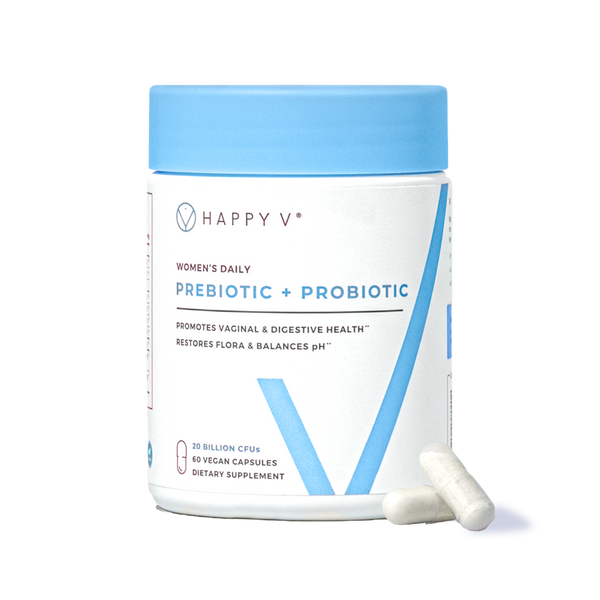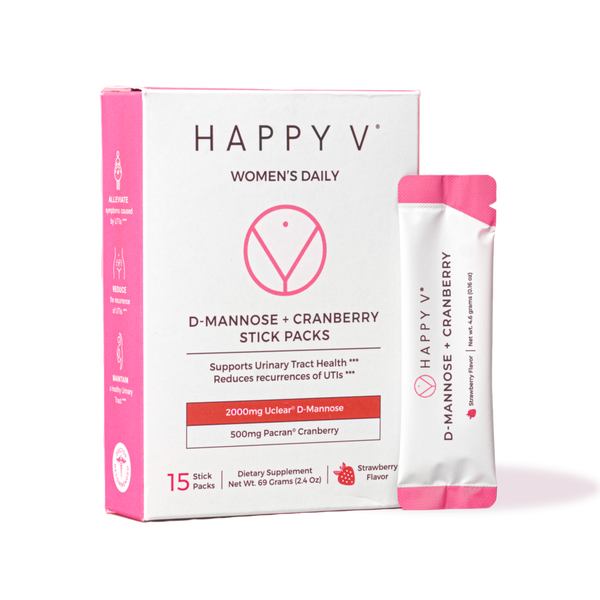- Fact Checked
- August 07, 2025
- 10 min read
Table of Contents
Table of Contents
Maintaining urinary tract health is an important part of overall wellness, especially for those who experience frequent discomfort or infections.
One ingredient that’s been generating a lot of buzz lately is D-Mannose, a naturally occurring sugar found in fruits like cranberries and apples, and often taken as a supplement to support urinary health.
You may have heard friends or influencers talking about it, but is D-Mannose really living up to the hype? In this article, we’ll explore the science behind D-Mannose and what it might mean for your urinary tract health.
This post is for informational purposes only and does not constitute medical advice. See full disclaimer below.
The Importance of Urinary Health: Recognizing the Signs of Trouble
A healthy urinary tract is essential for your body’s ability to filter waste, regulate fluids, and maintain overall comfort.
When everything’s working as it should, you probably don’t give your bladder or urinary system much thought. But when things go wrong (hey, uncomfortable burning sensation), the symptoms can quickly disrupt your daily life.
Urinary tract infections, or UTIs, are among the most common reasons people seek medical care for urinary issues. They occur when bacteria, most often E. coli, enter the urinary tract and cause infection. While anyone can develop a UTI, women are especially prone to them.
Common signs of a UTI include:
- A frequent, urgent need to urinate
- A burning or stinging sensation when you pee
- Cloudy, dark, or foul-smelling urine
- Lower abdominal or pelvic discomfort
- Feeling tired, shaky, or generally unwell
- In some cases, fever or back pain (which can signal a more serious infection)
Ignoring these warning signs can lead to more serious complications, including kidney infections. That’s why staying attuned to your urinary health and taking action at the first sign of trouble is so important.
What Is D-Mannose?
Let’s talk about D-Mannose, a naturally occurring simple sugar that might just become your new go-to for supporting urinary tract wellness. Found in fruits like cranberries, apples, oranges, peaches, and pears (even in coffee beans and baker’s yeast—who knew?), D-Mannose is technically a monosaccharide, which means it’s made up of just one sugar molecule.
Unlike glucose, D-Mannose isn’t rapidly absorbed or stored as fat, and it doesn’t cause sharp blood sugar spikes. That’s good news for anyone with insulin sensitivity!
How D-Mannose Supports Your Urinary Health
D-Mannose has been gaining attention as a natural way to support urinary tract health, especially for those of us dealing with urinary tract infections (UTIs) more often than we’d like.
Some early research and lab studies suggest that D-Mannose can interfere with E. coli (aka the bacterial culprit behind most UTIs) by stopping it from sticking to the lining of the bladder, urethra, urinary tract, and vagina. Instead of latching on and causing trouble, the bacteria bind to the D-Mannose and get flushed out when you pee. Pretty cool, right?
Another reason people are turning to D-Mannose instead of (or alongside) antibiotics? It’s fast-acting and doesn't harm your helpful bacteria. Plus, it may help reduce the risk of antibiotic resistance, which is becoming an increasing concern in the treatment of infectious diseases.
A 2013 randomized clinical trial involving 308 adult women found that D-Mannose worked just as well as a commonly prescribed antibiotic (nitrofurantoin) in preventing recurrent UTIs. A 2014 follow-up study reported D-Mannose helped relieve UTI symptoms during active infections—and was even more effective at preventing new ones compared to the control group.
Another pilot study noted that over 90% of participants felt better within three days of taking D-Mannose. While these results are promising, larger meta-analysis and systematic reviews are still needed to confirm the effectiveness of D-Mannose across different demographics and baseline conditions.
D-Mannose vs. Antibiotics: What’s the Difference?
When it comes to treating and preventing urinary tract infections (UTIs), antibiotics have long been the go-to option. They work by directly targeting and killing the bacteria responsible for the infection, often providing quick relief. But frequent or long-term use of antibiotics can throw off the balance of healthy bacteria in your body and contribute to the growing problem of antibiotic resistance—a serious public health issue that can make future infections harder to treat and limit your options down the road.
Because of these challenges, both patients and healthcare professionals are increasingly interested in non-antibiotic alternatives and additional ways to support urinary health. aD-mannose has emerged as a promising option, especially for those dealing with recurring infections.
Recent studies have compared D-mannose directly with antibiotics for both treatment and prevention of UTIs. Some clinical trials and reviews suggest that D-mannose may be just as effective as certain antibiotics (like nitrofurantoin) in preventing recurrent UTIs, and may also help ease symptoms when used alongside antibiotics during active infections. For example, one randomized clinical trial found that women taking D-mannose had a similar reduction in UTI recurrence as those taking nitrofurantoin, and a 2022 study suggested comparable cure rates between D-mannose and antibiotics for acute infections.
That said, the science is still evolving. While several studies show promise, especially for prevention, other research, including larger and more recent trials, has found less consistent results. Current medical guidelines still recommend antibiotics as the first-line treatment for active or complicated UTIs. Experts stress that D-mannose shouldn't replace antibiotics in cases of serious infection, and putting off proper treatment can lead to more serious complications.
For this reason, many healthcare providers see D-mannose as a helpful complement to antibiotic treatment, or as part of a prevention plan, rather than a full replacement. This kind of approach can reduce unnecessary antibiotic use and help lower the risk of resistance, while still making sure active infections are treated effectively.
Dr. Barry Peskin, an OB-GYN with more than 20 years of experience in women’s urinary health, shares his perspective:
“When I see patients who struggle with chronic UTIs, I always want to offer them more than just another round of antibiotics. I explain that D-mannose isn’t a cure-all, but for some, it can be a valuable tool, especially for prevention. We talk about how it works differently from antibiotics, and I encourage patients to consider it as part of a broader strategy that includes hydration, healthy habits, and regular check-ins. The goal is to empower them with options that support their long-term wellbeing.” - Dr. Peskin
To put a long story short: antibiotics are still essential for treating active or severe UTIs and preventing complications, but D-mannose offers a promising, non-antibiotic way to help break the cycle of recurrent infections and reduce reliance on antibiotics over time. As always, the best next step is to talk with your healthcare provider about what’s right for you.
Who May Benefit
If you’ve ever felt stuck in the never-ending loop of recurrent urinary tract infections or frequent UTIs, D-Mannose might be worth chatting with your clinician about.
It could be especially useful if you:
- Are sexually active with multiple partners
- Use urinary catheters
- Are going through menopause or are a postmenopausal woman
- Are pregnant
- Live with diabetes (lower immunity and less of the antimicrobial peptide psoriasin can raise your risk)
- Have kidney stones or hormonal imbalances
- Are recovering from urinary surgery
It’s not just for women, either. Men can benefit too, especially those with risk factors like chronic health issues or catheter use. It may also support patients in primary care or urology settings as part of a prophylactic or non-antibiotic urinary health strategy.
Use, Dosage, and Safety
How much D-Mannose should you take? That depends on whether you’re using it to treat UTIs or for UTI prevention:
- Acute UTIs: 2g every 2–3 hours (then taper as symptoms ease)
-
Daily prophylactic use: 1g once a day, or split into smaller doses throughout the day
Always read the instructions on your dietary supplement label and check in with your healthcare provider before starting, especially if you’re pregnant, breastfeeding, managing diabetes, or taking other medications.
Pro tip: If you’re using D-Mannose powder during an active UTI, drink lots of water! That extra hydration helps flush out bacteria more effectively.
If your symptoms don’t improve or if they worsen (think: fever, nausea, chills), definitely contact your doctor. Some complicated UTIs or bacterial infections require urgent antibiotic treatment.
Side Effects
D-Mannose is generally considered safe for most people when used appropriately, but like any supplement, it’s important to be aware of possible side effects and risks, especially if you have underlying health conditions.
Most people tolerate D-Mannose well, but some may experience mild digestive issues such as:
- Loose stools or mild diarrhea
- Bloating or gas
These effects are typically temporary and tend to occur at higher doses. However, taking very large amounts of D-Mannose may put stress on the kidneys, particularly in people with existing kidney problems. If you have a history of kidney disease or impaired kidney function, it’s essential to consult your healthcare provider before using D-Mannose.
There’s also some concern that D-Mannose could affect blood sugar levels, so individuals with diabetes should use caution and monitor their blood glucose regularly if taking this supplement.
D-Mannose has not been thoroughly studied in pregnant or breastfeeding women, or in children. Until more research is available, it’s best to avoid D-Mannose in these groups unless specifically recommended by a healthcare professional.
Beyond UTIs: Bacterial Vaginosis and Gut Health
BV (bacterial vaginosis) affects over 21 million women in the U.S. every year. It occurs when the balance of good and bad bacteria in the vagina gets thrown off.
While antibiotics are typically prescribed for active cases, D-Mannose may offer additional support in maintaining vaginal flora and possibly preventing reinfections.
There’s also some discussion about D-Mannose acting as a prebiotic, aiding in the growth of beneficial microbes. In combination with probiotics, it may support gut health and reduce inflammation, contributing positively to immune system balance and overall quality of life.
Supplement Selection and Considerations
When choosing D-Mannose supplements:
- Look for clean, additive-free formulas
- Choose your preferred form—capsule, D-Mannose powder, or tablet
- Read the label and verify dosage
Some brands, like Happy V, combine D-Mannose with cranberry for a multi-targeted approach to urinary health. Together, D-Mannose and cranberry offer targeted support for flushing unwanted bacteria from the urinary system and may help reduce the risk of recurrent urinary tract infections when used consistently.
While not a treatment for active infections, Happy V’s D-Mannose + Cranberry pills are designed to complement a healthy lifestyle and provide ongoing support for your urinary tract, especially if you're prone to frequent discomfort. As always, consult with your healthcare provider to see if this supplement is a good fit for your needs.
D-Mannose + Cranberry
Supports urinary tract health and promotes long-term wellness.
Final Thoughts
D-Mannose may not be a silver bullet, but it’s a compelling, science-supported option to explore—especially if you're navigating life with recurrent UTIs or looking to reduce antibiotic use.
From support with acute cystitis to prophylaxis and beyond, D-Mannose represents a potential shift in how we think about urinary health. Backed by growing evidence and supported by both pilot studies and controlled trials, it’s a non-antibiotic alternative that’s easy to incorporate and may help maintain your quality of life.
Just remember: consistency, hydration, and communication with your healthcare team are key.
Keep the Conversation Going
- Visit our blog for more women’s health tips.
- Join our private Happy V Facebook group to hear from others who’ve been there.
- Explore supplements designed to support your vaginal health journey.
Disclaimer: This blog is for informational and educational purposes only and is not intended to diagnose, treat, cure, or prevent any disease. Statements about supplements have not been evaluated by the Food and Drug Administration. For more information about vaginal infections, visit the CDC or speak to a licensed healthcare provider.
FAQ
Is D-mannose the same as cranberry?
Where Does D-Mannose Come From?
What is the difference with Happy V D-Mannose + Cranberry Stick Packs and Happy V D-Mannose + Cranberry capsules?
Our experts continually monitor the health and wellness space, and we update our articles when new information becomes available.
- Published on: August 07, 2025
- Last updates: August 07, 2025
Written by Hans Graubard
Edited by Hans Graubard
Our experts continually monitor the health and wellness space, and we update our articles when new information becomes available.
- Published on: August 07, 2025
- Last updates: August 07, 2025
Written by Hans Graubard
Edited by Hans Graubard









